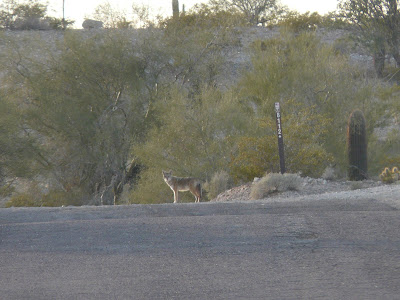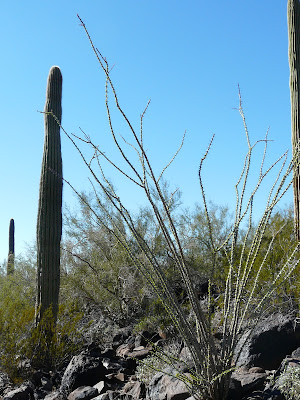Here is some images from our extraordinary visit at Cabeza Prieta NWR in Ajo, AZ (south of Phoenix). In the photos below are Jim (right below) and Amanda, Kim and Paul in the next photo. Kim and Jim are biologists at Cabeza while Amanda and Paul are two other SCA interns, spending a year serving at CPNWR. Amanda and Paul also shared the house we lived in, which was across the street from the refuge office complex. This made for a nice, short commute to work!
Here are Margot and Sid - two long-time employees of Cabeza Prieta and super-nice folks to work with. Margot and her family invited us over for their annual Super Bowl Party. It was a great time and a great game and very nice of them to include us.
Cabeza Prieta NWR is in Southern Arizona on 860,010 acres, the third largest NWR in the lower 48 states. It is the size of the state of Rhode Island, has seven mountain ranges, and shares a 56-mile border with Sonora, Mexico. It was founded in 1939 and over 90% of the refuge wass designated as "wilderness" in 1990 through the Arizona Wilderness Act. To summarize, it is a HUGE place and most of it is NOT accessible other than on foot or on gravel roads that require high-clearance 4-wheel drive vehicles. It is a vast and rugged landscape within the Sonoran Desert. "Cabeza Prieta" is Spanish for "dark head", referring to the lava-topped granite peaks in a remonte mountain range in its western corner.
We hope you enjoy ALL of these photos of our various trips into the Sonoran Desert. We became obsessed with the Saguaro Cactus and took zillions of photos in the hopes of being able to remember this beautiful area just as it is. This blog post is just a sampling of the total number of pictures that we took during our visit at Cabeza Prieta NWR.

Above and below are photos of the Chain Fruit Cholla (Choy-ya). This plant is all over the Sonoran Desert and is extremely unusual to look at (at least we think so).
Here are some images of the house we lived in at CPNWR. It was a 4BR, so we each had our own space. It also had Wi-Fi, which meant we could watch live sporting events at night.
Here are some shots of the office complex for CPNWR. The grounds are perfectly-landscaped to reflect what you find on throughout the refuge and around the town of Ajo. There was also a very nice nature trail that provides visitors with an introduction to the wildlife and vegetation from the area.
Our work space was smack-dab in the middle of the office, providing a nice way to socialize with everyone.
The visitor's center and gift store was also part of the office complex.
There were regular sightings of coyotes all around us; in town, in the desert, on the refuge....they were very common to see, but still a thrill.
This coyote was camera shy and way too fast for me!
Oliver, Paul and I went to the annual "Fiddle Festival" concert one night and enjoyed a good 'ole slice of Americana. There were stringed-musicians from all over the country who had traveled to Ajo for this event.
One night, Paul took us up to Childs Mountain to watch the sunrise. The mountaintop area was accessible in a high-clearance truck, but the road was not very well maintained. We had a nice time with Paul and certainly enjoyed the scenery all around.
Above is a view from Childs Mountain of the city of Ajo at dusk. Below is the nature trail at the office.
Because of some rains that we experienced at the start of our visit, the brittlebush were blooming these little yellow flowers EVERYWHERE. The bush above was along the refuge nature trail.
The nature trail has a viewing hut for bird-watching.
The nature trail houses a pool of desert pupfish, an endangered species.
This is Shawn and Kim, both are biologists at CPNWR.
On our final day at Cabeza, Mary and Linda took us out on the refuge for an absolutely wonderful afternoon. Our final destination was the Charlie Bell trail and well, which passes the part of the refuge where the Sonoran Pronghorn are being reintroduced. The Sonoran Pronghorn are an endangered species and the refuge has been working for the past several years at raising them in captivity, then releasing them. Through their efforts the population as gone from less than 20 to over 200 today.
At the top of the hill in the above photo is the viewing hut that we will hike to in hopes of seeing some Pronhorn in their large pen in the valley below. This is as close as you are allowed to them. Below Oliver, Linda and Mary are packing their bags for the hike. We had plenty of water with us for the various adventures we took that afternoon.
We were so lucky to be able to actually see the Sonoran Pronghorn! If you look closely at these two photos, you can see them drinking and eating at their troughs. It was a very warm afternoon, so we were afraid that they would be lounging in the shade during our stop en route to the Charlie Bell area of the refuge. We all got good looks at them through the binoculars and my camera did a great job on the highest zoom possible.
Reptiles hibernate during the winter, but this little lizard was out sunning himself.
Mary (in the dark top), Linda and Oliver hiking down to the CB well. As you can see by the photos, we were out in the midst of the refuge without a soul around. It was a fun afternoon and we are grateful to have had this opportunity to get out of the office and see a small piece of this vast area.
Here is the crew at the Charlie Bell well area.....yes there is actually water here.
Above is an ocotillo bush that has green leaves, something that only happens after a good rain. These bushes otherwise go dormant and look like dead sticks. We were happy to be able to see the rewards of a rare desert rain during our visit.
The Charlie Bell area has Native American Petroglyphs carved into the rocks at various places. These are just two of the many we saw during our hike.
I LOVE THESE IMAGES! This is exactly how it looked - can you believe how dense the Saguaro are?
Now we are into some photos of the town of Ajo. It is a very simple place, with one main drag. Our house was behind the Woody's gas station. Notice the pretty pink sunset in the background.
The town square has a very traditional Spanish flare with the white adobe buildings and the palm trees.
This Chinese restaurant was one of only five restaurants in town and was within walking distance to our house. We ate there only once and enjoyed the food and the prices!

























































































































No comments:
Post a Comment